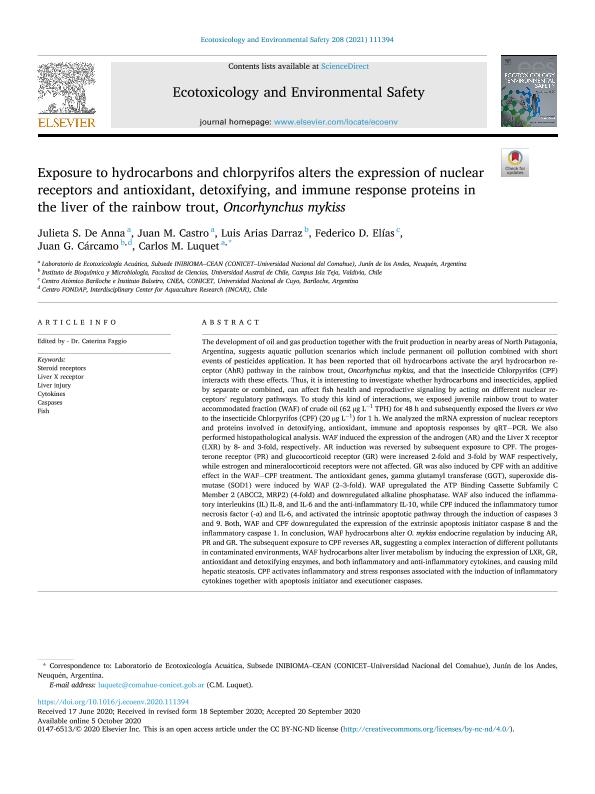Artículo
Exposure to hydrocarbons and chlorpyrifos alters the expression of nuclear receptors and antioxidant, detoxifying, and immune response proteins in the liver of the rainbow trout, Oncorhynchus mykiss
de Anna, Julieta Soledad ; Castro, Juan Manuel
; Castro, Juan Manuel ; Arias Darraz, Luis; Elías, Federico
; Arias Darraz, Luis; Elías, Federico ; Cárcamo, Juan Guillermo; Luquet, Carlos Marcelo
; Cárcamo, Juan Guillermo; Luquet, Carlos Marcelo
 ; Castro, Juan Manuel
; Castro, Juan Manuel ; Arias Darraz, Luis; Elías, Federico
; Arias Darraz, Luis; Elías, Federico ; Cárcamo, Juan Guillermo; Luquet, Carlos Marcelo
; Cárcamo, Juan Guillermo; Luquet, Carlos Marcelo
Fecha de publicación:
01/2021
Editorial:
Elsevier
Revista:
Ecotoxicology and Environmental Safety
ISSN:
0147-6513
Idioma:
Inglés
Tipo de recurso:
Artículo publicado
Clasificación temática:
Resumen
The development of oil and gas production together with the fruit production in nearby areas of North Patagonia, Argentina, suggests aquatic pollution scenarios which include permanent oil pollution combined with short events of pesticides application. It has been reported that oil hydrocarbons activate the aryl hydrocarbon receptor (AhR) pathway in the rainbow trout, Oncorhynchus mykiss, and that the insecticide Chlorpyrifos (CPF) interacts with these effects. Thus, it is interesting to investigate whether hydrocarbons and insecticides, applied by separate or combined, can affect fish health and reproductive signaling by acting on different nuclear receptors’ regulatory pathways. To study this kind of interactions, we exposed juvenile rainbow trout to water accommodated fraction (WAF) of crude oil (62 μg L−1 TPH) for 48 h and subsequently exposed the livers ex vivo to the insecticide Chlorpyrifos (CPF) (20 µg L−1) for 1 h. We analyzed the mRNA expression of nuclear receptors and proteins involved in detoxifying, antioxidant, immune and apoptosis responses by qRT−PCR. We also performed histopathological analysis. WAF induced the expression of the androgen (AR) and the Liver X receptor (LXR) by 8- and 3-fold, respectively. AR induction was reversed by subsequent exposure to CPF. The progesterone receptor (PR) and glucocorticoid receptor (GR) were increased 2-fold and 3-fold by WAF respectively, while estrogen and mineralocorticoid receptors were not affected. GR was also induced by CPF with an additive effect in the WAF−CPF treatment. The antioxidant genes, gamma glutamyl transferase (GGT), superoxide dismutase (SOD1) were induced by WAF (2–3-fold). WAF upregulated the ATP Binding Cassette Subfamily C Member 2 (ABCC2, MRP2) (4-fold) and downregulated alkaline phosphatase. WAF also induced the inflammatory interleukins (IL) IL-8, and IL-6 and the anti-inflammatory IL-10, while CPF induced the inflammatory tumor necrosis factor (-α) and IL-6, and activated the intrinsic apoptotic pathway through the induction of caspases 3 and 9. Both, WAF and CPF downregulated the expression of the extrinsic apoptosis initiator caspase 8 and the inflammatory caspase 1. In conclusion, WAF hydrocarbons alter O. mykiss endocrine regulation by inducing AR, PR and GR. The subsequent exposure to CPF reverses AR, suggesting a complex interaction of different pollutants in contaminated environments, WAF hydrocarbons alter liver metabolism by inducing the expression of LXR, GR, antioxidant and detoxifying enzymes, and both inflammatory and anti-inflammatory cytokines, and causing mild hepatic steatosis. CPF activates inflammatory and stress responses associated with the induction of inflammatory cytokines together with apoptosis initiator and executioner caspases.
Palabras clave:
CASPASES
,
CYTOKINES
,
FISH
,
LIVER INJURY
,
LIVER X RECEPTOR
,
STEROID RECEPTORS
Archivos asociados
Licencia
Identificadores
Colecciones
Articulos(CCT - PATAGONIA NORTE)
Articulos de CTRO.CIENTIFICO TECNOL.CONICET - PATAGONIA NORTE
Articulos de CTRO.CIENTIFICO TECNOL.CONICET - PATAGONIA NORTE
Citación
de Anna, Julieta Soledad; Castro, Juan Manuel; Arias Darraz, Luis; Elías, Federico; Cárcamo, Juan Guillermo; et al.; Exposure to hydrocarbons and chlorpyrifos alters the expression of nuclear receptors and antioxidant, detoxifying, and immune response proteins in the liver of the rainbow trout, Oncorhynchus mykiss; Elsevier; Ecotoxicology and Environmental Safety; 208; 1-2021; 1-11
Compartir
Altmétricas



